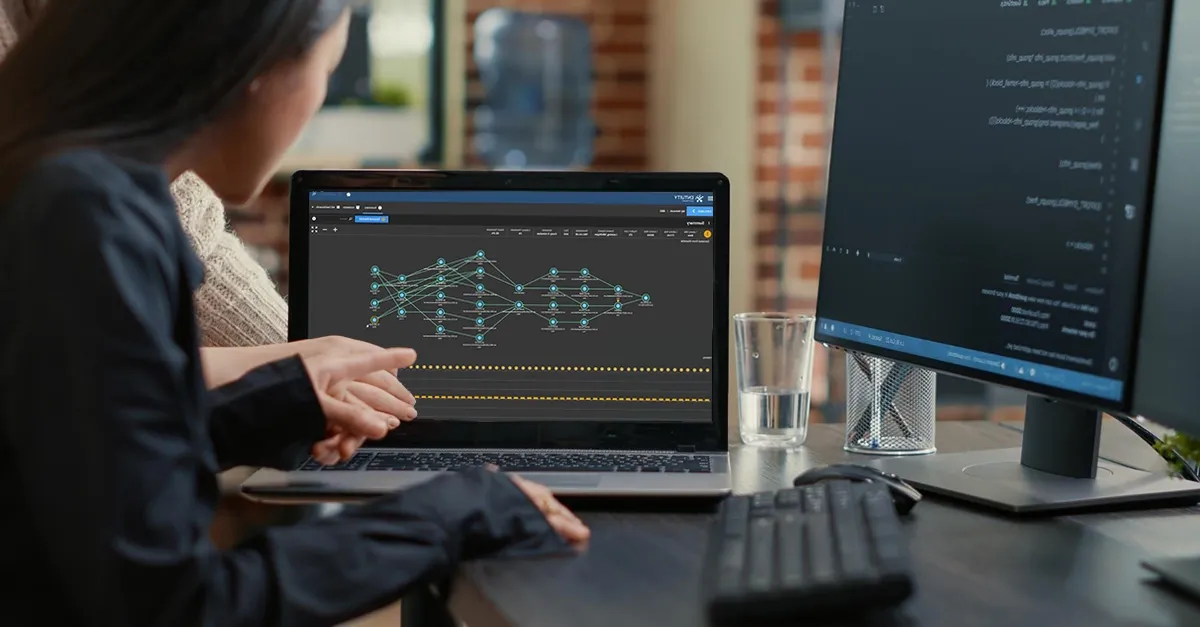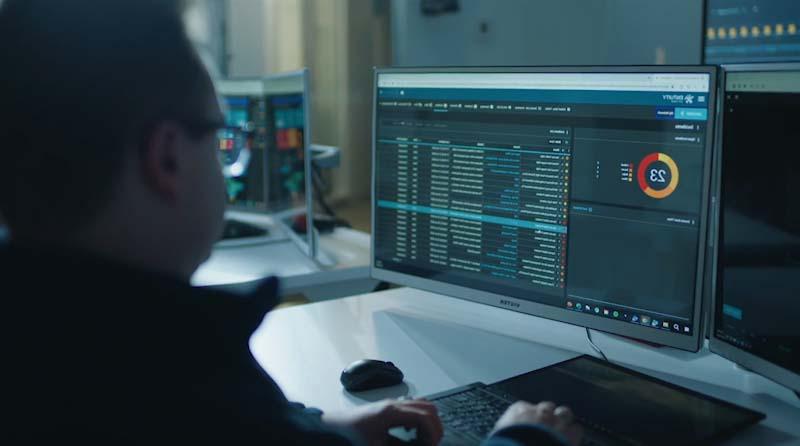What Is Network Observability (vs. Monitoring)? – Observability Use Cases
Entuity Software
When you think about your network, chances are good you imagine servers and routers, switches, and firewalls. However, what about its internal state? What bottlenecks are occurring and where? Where is demand from users growing and where is it fading? What resources are being stretched thin?
These are all elements of network observability – a critical consideration for ensuring that you can identify barriers, maximize uptime and achieve mission-critical goals for the business.
Jump-to Section
What Is Network Observability?
Importance of IT Observability
Network Observability vs. Monitoring
Network Observability vs. Visibility
Network Observability vs. Telemetry
Pillars of Network Observability
Common Network Observability Challenges
3 Network Observability Use Cases
1. Root Cause Analysis and Debugging
What Is Network Observability?
Network observability is the ability to easily identify and answer questions about your network in real-time, and then use that information to make informed decisions to manage and optimize network resources and assets.
The Importance of IT Observability
Why does observability data matter? Ultimately, your team needs to maintain data center uptime and be able to identify or even predict points of failure. With the breadth of IT tools available today, it is inexcusable to be surprised by downtime. Having observability metrics like CPU and memory usage, logs and trace data at your fingertips can help you prevent costly network downtime or reduce MTTR if it is unavoidable.
How does observability stack up against other critical elements of IT resiliency, like monitoring, visibility, and telemetry? In this section, we’ll explore the most important things to know about IT observability.
Network Observability vs. Monitoring
As mentioned already, network observability is the ability to answer questions about the internal state of your network based on visibility into the network and its related assets. In comparison, monitoring is the practice of keeping tabs on network activity and asset conditions. This can be achieved through network monitoring tools, methods, and protocols, including SNMP polls and traps, SFlow and J0Flow, network logging, and alerting. Monitoring is usually automated, although acting on the data surfaced through monitoring frequently requires human intervention. It’s also usually focused on device health, rather than on network health from an end-user perspective.

Network Observability vs. Visibility
Observability and visibility can seem pretty similar, but the truth is that they differ dramatically. Whereas network observability is the ability to answer questions about network conditions and performance, network visibility is the result of monitoring. It’s the data surfaced by using the tools and protocols we mentioned above. While this does imply understanding things that are happening in the network, it is not as comprehensive as observability. It is also still focused primarily on individual network assets, rather than the bigger picture, and it does not take an end-user perspective.
Network Observability vs. Telemetry
Telemetry is a tool or protocol used to collect data from different systems. In fact, you can define telemetry as an act – the act of collecting data from remote systems. However, to be effective, the information collected must be standardized and transformed for human use. As such, telemetry is part of the network observability process, but it’s also part of the conventional monitoring process.
Pillars of Network Observability
Network observability is built on three individual pillars – event logs, metrics, and traces. However, it should be noted that simply enabling logs, metrics and traces will not make a system more observable. Your IT team must use your observability infrastructure to unlock the information necessary to create stronger, more resilient systems in the long run.
Using these three metrics, developers can create a more observable network.
Focus on End-Users
First, they must focus on end-user experience instead of network asset functionality or condition. The end-user experience should be the defining metric of network functionality. After all, it doesn’t really matter which assets are working at peak capacity and which are not if you’re unable to deliver an optimal user experience. That will simply lead users to defect to other systems, resulting in damaged user/customer satisfaction, and even damage to the organization’s market share.
Leverage Telemetry
In addition to focusing on end-user experience, organizations must use telemetry for NetOps. The most relevant types of telemetry for network monitoring include device telemetry, synthetic data, and data configuration.
Model the Right Data
Finally, it’s crucial that organizations can ensure service assurance. By building an observability platform or system using the appropriate telemetry methods, it becomes possible to cleanse data and then model it effectively. This guarantees high-quality data for the observability platform, which then generates more relevant information to keep teams informed about the condition of the network at all times.
Common Network Observability Challenges
Network observability is not always easy to achieve. Several common challenges can affect the success of your distributed systems observability. We explore three of those below.
Environment Complexity – The more complex an IT environment, the harder it is to achieve observability into your system. This is particularly true in today’s incredibly complex, ever-changing cloud and hybrid cloud environments where resources can be scaled or added and subtracted at the drop of a hat.
This complexity is amplified for acquisitive companies that frequently need to integrate new networks into their existing environment. Fortunately, network discovery software and network automation techniques have reduced the friction of these processes.
Misrepresentative Pre-Production Environments – While great advances have been made in testing during the development process, it remains impossible to accurately predict the impact of human users on a system while that system is in pre-production. System or application observability usually must wait until the code is published.

Data Silos – Data silos are problematic in all organizations, although they were once considered unavoidable. They came about because of data ownership by individual departments, but today, information must be free to move across an entire organization. With data locked into silos, it becomes impossible to understand interdependencies across the entire environment. This is particularly true while moving to the cloud, which can involve multiple clouds and digital channels.
Top 3 Network Observability Use Cases
How does network observability impact real-world network usage? Below, we’ll touch on three of the most important observability use cases to understand.
1. Root Cause Analysis and Debugging
Debugging can be incredibly challenging thanks to the distributed nature of networks. The ability to quickly triangulate and identify the root cause of an issue is hampered. With observability tools, this is a thing of the past. Developers, systems engineers, and technicians can answer critical questions based on accurate network diagnostics to identify the root cause of problems and ensure accurate debugging.
2. Informing Network Architecture
System design is always a huge concern. The right network architecture is essential for a wide range of considerations, from operability and reliability to ensuring communications across an organization. Through network observability, it becomes possible to answer questions like whether an OSPF design is working correctly. It also becomes possible to accurately forecast network convergence and predict how convergence will change with more devices added to the network.
3. IT Reporting
Reporting is a critical consideration but generating information can be challenging. It requires asking the right questions and then being able to access relevant information. For instance, by asking what has changed in the network in the preceding 24 hours, it’s possible to create daily reports that inform team members and allow them to develop an accurate, shared understanding of the network’s condition.
Simplify Your Network Management with the Right Partner
Whether you’re seeking tools to further empower your IT team, or you’re interested in a hands-off managed approach, Park Place Technologies can provide comprehensive network support.
Entuity, our leading enterprise network monitoring software, can help your team quickly discover devices, visualize your network topology, easily filter and manage events, and analyze system flow. Entuity is observability made easy, and can help your team proactively identify and remediate network issues.
For a more automated approach to network management, opt for managed IT infrastructure services like Park Place Managed Services™. This can act as a force multiplier for your team, providing integrated management across multiple layers to streamline your storage, server, and networking environments. We even supplement with network hardware maintenance to ensure your devices don’t create bottlenecks.
Contact Park Place Technologies today so we can better understand and solve for your organization’s unique needs!



